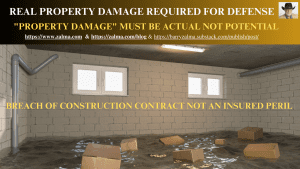Real Property Damage Required for Defense

Post 4771
See the full video at https://rumble.com/v4nnf3u-real-property-damage-required-for-defense.html and at https://youtu.be/z2azn1FG2EQ
Breach of Construction Contract Not an Insured Peril
After the plaintiff’s motion for summary judgment was rejected and the defendant insurer’s motion for summary judgment was granted the plaintiff appealed. In Westchester Modular Homes Of Fairfield County, Inc. v. Arbella Protection Insurance Company, No. AC 45433, Court of Appeals of Connecticut (April 2, 2024) and the Court of Appeals resolved the dispute.
FACTS
On or about April 27, 2016, the plaintiff entered into a contract with Diana Lada L’Henaff and Jean Jacques L’Henaff for the construction of a new modular home on property located in New Canaan (property). During construction, disputes arose between the L’Henaffs and the plaintiff. Ultimately, the L’Henaffs terminated their contract with the plaintiff on December 14, 2016. The plaintiff filed a mechanic’s lien on the property on or about February 3, 2017, and commenced an action to foreclose on the lien on or about April 7, 2017 (underlying litigation).
The L’Henaffs filed a counterclaim that alleged that they “desired to build a modern home and had very carefully and specifically specified the type of insulation, materials, and finishes that they required the builder that won the job to satisfy.” The L’Henaffs alleged that work on the project progressed slowly and with constant problems. The L’Henaffs alleged that the plaintiff had breached the construction contract.
The plaintiff, as a named insured under a commercial general liability policy issued by the defendant (policy), filed a claim for coverage with the defendant which was refused. The defendant disclaimed coverage on the basis that the first revised counterclaim filed in the underlying litigation did not allege “property damage” caused by an “occurrence” and, therefore, it did not trigger coverage under the policy.
The trial court determined that the pleadings in the underlying litigation did not allege property damage. As to the extrinsic documents submitted to the defendant by the plaintiff, the court determined that such evidence established only the existence of possible defective work that could lead to future property damage if not remedied but that it did not demonstrate the existence of current property damage.
DISCUSSION
Because there are no factual issues in dispute in the present case, the court was only faced with the legal question whether the defendant had a duty to defend the plaintiff. Specifically, the defendant contended that the extrinsic documents suggested, “at most, that the construction deficiencies could potentially result in water damage to nondefective areas of the property if not fixed.” (Emphasis in original)
The Plaintiffs alleged construction defects and did not allege damage that the defects caused to other, nondefective property. Since the plaintiffs expert testified that he had identified defective work that, if not remedied, could lead to property damage in the future but identified no damage, Plaintiffs failed to allege facts bringing the underlying litigation seeking property damage that would have required a defense.
The Court of Appeals made clear that repairs to structural deficiencies, made for the purpose of preventing physical injury to tangible property before the alleged deficiency has caused property damage are not within the insuring agreement’s definition of property damage.
Because there was no indication of water damage at all. At most, the construction deficiencies could potentially result in water damage to nondefective areas of the property if not fixed. Damage to nondefective property in the form of rot or mold caused by water intrusion would be property damage within the terms of the policy language. However, the plaintiff did not present any evidence of actual damage or case law holding that the presence of water, in the absence of actual damage, amounts to covered physical damage.
The Court of Appeals concluded that the notification of the mere presence of water, without some corresponding physical damage, did not provide the defendant with actual knowledge of facts establishing a reasonable possibility of coverage because the presence of water does not constitute property damage within the terms of the policy.
Accordingly, the defendant did not have a duty to defend the plaintiff in the underlying litigation, and the court properly rendered summary judgment in favor of the defendant.
When an insured breaches the terms of a construction contract it will invariably be sued by the other party to the contract for damages resulting from the breach. Westchester Modular Homes breached its contract by creating a defective modular home that would, in the future, if defects were not cured, suffer physical damage. Since there was no physical damage to the structure – just the potential of damage – coverage did not apply and Westchester was obligated to defend and indemnify itself to the allegations of the underlying litigation.
 (c) 2024 Barry Zalma & ClaimSchool, Inc.
(c) 2024 Barry Zalma & ClaimSchool, Inc.
Please tell your friends and colleagues about this blog and the videos and let them subscribe to the blog and the videos.
Subscribe to my substack at https://barryzalma.substack.com/publish/post/107007808
Go to X @bzalma; Go to Newsbreak.com https://www.newsbreak.com/@c/1653419?s=01; Go to Barry Zalma videos at Rumble.com at https://rumble.com/c/c-262921; Go to Barry Zalma on YouTube- https://www.youtube.com/channel/UCysiZklEtxZsSF9DfC0Expg.
Go to the Insurance Claims Library – https://lnkd.in/gwEYk.
Like this:
Loading…



